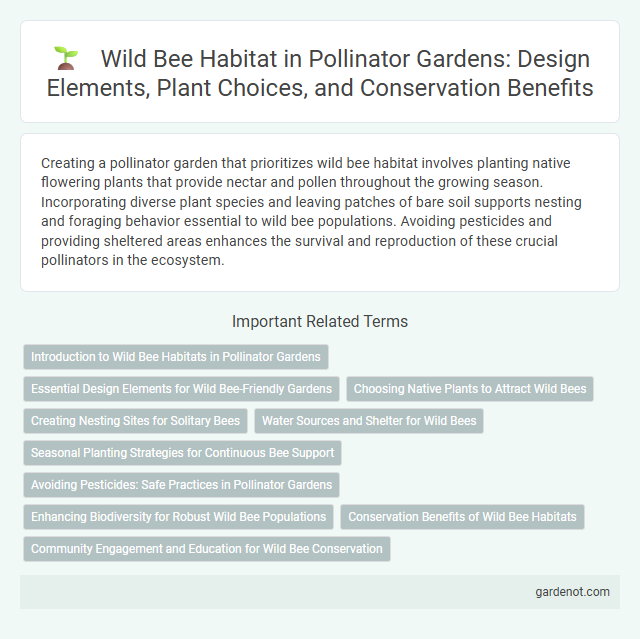Creating a pollinator garden that prioritizes wild bee habitat involves planting native flowering plants that provide nectar and pollen throughout the growing season. Incorporating diverse plant species and leaving patches of bare soil supports nesting and foraging behavior essential to wild bee populations. Avoiding pesticides and providing sheltered areas enhances the survival and reproduction of these crucial pollinators in the ecosystem.
Introduction to Wild Bee Habitats in Pollinator Gardens
Wild bee habitats in pollinator gardens provide essential nesting sites and diverse floral resources that support the survival and reproduction of native bee species. These habitats typically include undisturbed soil, dead wood, and native plants, creating an environment where wild bees can thrive year-round. Incorporating varied plant structures and continuous bloom periods enhances habitat suitability and promotes biodiversity within pollinator gardens.
Essential Design Elements for Wild Bee-Friendly Gardens
In a pollinator garden, essential design elements for wild bee habitat include planting a diverse array of native flowering plants that provide continuous blooms throughout the growing season, ensuring ample pollen and nectar sources. Incorporating bare soil patches, dead wood, and nesting materials like hollow stems supports ground-nesting and cavity-nesting bee species. Avoiding pesticides and maintaining structural diversity with shrubs and grasses further enhance the garden's suitability for wild bees.
Choosing Native Plants to Attract Wild Bees
Selecting native plants such as purple coneflower, goldenrod, and bee balm provides optimal nectar and pollen sources essential for wild bee nutrition and reproduction. Native plant diversity supports various wild bee species by matching their foraging preferences and blooming periods, enhancing habitat suitability. Incorporating clusters of these plants in a pollinator garden increases wild bee visitation and contributes to local biodiversity conservation.
Creating Nesting Sites for Solitary Bees
Creating nesting sites for solitary bees involves providing bare soil, dead wood, and hollow stems within pollinator gardens, essential for their reproduction and survival. These habitats support key species like mason bees and leafcutter bees, which contribute significantly to pollination efficiency. Incorporating diverse nesting materials enhances biodiversity and strengthens local ecosystems by sustaining wild bee populations.
Water Sources and Shelter for Wild Bees
Water sources such as shallow ponds, damp sand, or mud provide essential hydration and materials for wild bee nesting and brood development. Shelter options including undisturbed soil, hollow stems, and leaf litter create safe nesting sites and protection from predators and harsh weather. Incorporating diverse microhabitats within a pollinator garden enhances the survival and reproduction of wild bee populations.
Seasonal Planting Strategies for Continuous Bee Support
Seasonal planting strategies in pollinator gardens enhance wild bee habitat by providing a continuous supply of nectar and pollen throughout the year. Selecting native plants that bloom in succession from early spring to late fall ensures that wild bees have consistent foraging resources during critical life stages. Incorporating diverse flowering species like goldenrods, coneflowers, and asters supports a wide range of wild bee species by matching their specific seasonal activity patterns.
Avoiding Pesticides: Safe Practices in Pollinator Gardens
Protecting wild bee habitats in pollinator gardens requires avoiding the use of harmful pesticides that disrupt bee foraging and reproduction. Implementing integrated pest management (IPM) strategies and opting for organic alternatives promotes a safe environment for native bee populations like bumblebees, mason bees, and leafcutter bees. Maintaining pesticide-free zones with diverse flowering plants supports pollinator health and biodiversity essential for ecosystem balance.
Enhancing Biodiversity for Robust Wild Bee Populations
Creating diverse wild bee habitats with native flowering plants supports the germination of multiple bee species, enhancing biodiversity and promoting ecosystem resilience. Incorporating varied floral structures and bloom times ensures continuous forage resources, which are critical for robust wild bee populations. Habitat features like nesting sites in undisturbed soil and woody debris also contribute to sustaining healthy and diverse wild bee communities.
Conservation Benefits of Wild Bee Habitats
Wild bee habitats support biodiversity by providing essential nesting sites and diverse floral resources, enhancing pollination efficiency for native plants and crops. Conserving these habitats stabilizes wild bee populations, which are critical for ecosystem resilience and agricultural productivity. Preserving wild bee environments also mitigates the decline caused by habitat loss, pesticide exposure, and climate change, ensuring sustainable pollination services.
Community Engagement and Education for Wild Bee Conservation
Community engagement in wild bee habitat conservation fosters awareness and participation through workshops and local planting initiatives, enhancing pollinator-friendly gardens. Educational programs emphasize the importance of native wild bees in ecosystem health, encouraging practices like reduced pesticide use and diverse floral planting. These efforts strengthen community stewardship, ensuring sustainable habitats and boosting wild bee populations crucial for pollination services.
Wild bee habitat Infographic

 gardenot.com
gardenot.com